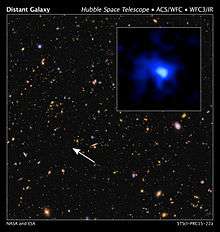EGS-zs8-1
| EGS-zs8-1 | |
|---|---|
 EGS-zs8-1 viewed by the Hubble Space Telescope | |
| Observation data (J2000[1] epoch) | |
| Constellation | Boötes[1] |
| Right ascension | 14h 20m 34.89s[1] |
| Declination | +53° 00′ 15.4″[1] |
| Redshift | 7.7[1] |
| Distance | 4 Gpc (13×109 ly) |
| Characteristics | |
| Type | Lyman-break galaxy |
| Size | 15,000 ly (diameter) |
EGS-zs8-1 is a high-redshift Lyman-break galaxy found at the northern constellation of Boötes.[2] In May 2015, EGS-zs8-1 had the highest spectroscopic redshift of any known galaxy, meaning EGS-zs8-1 was the most distant and the oldest galaxy observed.[3][4] In July 2015, EGS-zs8-1 was surpassed by EGSY8p7 (EGSY-2008532660), as the most distant and oldest galaxy observed.[5]
Description
The redshift of EGS-zs8-1 was measured at z = 7.73, corresponding to a light travel distance of about 13.04 billion light years from Earth, and age of 13.04 billion years. The galaxy shows a high rate of star formation, so it releases its peak radiation at the vacuum ultraviolet part of the electromagnetic spectrum, near the 121.567 nm (1,215.67 Å) Lyman-alpha emission line due to the intense radiation from newly formed blue stars, hence it is classified as a Lyman-break galaxy; high-redshift starburst galaxies emitting the Lyman-alpha emission line. Because of the cosmological redshift effect caused by the metric expansion of space, the peak light from the galaxy has become redshifted and has moved into the infrared part of the electromagnetic spectrum.[2] The galaxy has a comoving distance (light travel distance multiplied by the Hubble constant, caused by the metric expansion of space) of about 30 billion light years from Earth.[6]
EGS-zs8-1 was born 670 million years after the Big Bang, during the period of reionization, and it's 15 percent the size of the Milky Way. The galaxy was found to be larger than its other neighbors in that period when the universe was still very young.[4] Its mass at the time the light was emitted is estimated to have been about 15% of the Milky Way's current mass. The galaxy was making new stars at roughly 80 times the rate of the current Milky Way, or equivalent to 800 M☉ worth of material turning to stars every year.[6] The light reaching Earth was made by stars in EGS-zs8-1 that were 100 million to 300 million years old at the time they emitted the light.[7] The age of EGS-zs8-1 places it in the reionization phase of creation, a time when hydrogen outside the galaxies was switching from a neutral to ionized state. According to the galaxy's discoverers, EGS-zs8-1 and other early galaxies were likely the causes of reionization.[8][9]
Discovery
In 2013, Yale astronomer Pascal Oesch spotted an unexpected bright object while looking at Hubble Space Telescope images. He then confirmed the existence of the object using the Spitzer Space Telescope.[4] Redshift calculations, using the Multi-Object Spectrometer for Infrared Exploration (MOSFIRE) equipment at the W.M. Keck Observatory in Hawaii, were then performed to precisely determine the age of the galaxy.[8] Oesch and his colleagues at Yale and the University of California, Santa Cruz announced the find, which was named EGS-zs8-1, in May 2015 surpassing the previous record for oldest galaxy by about 30 million years.[4]
References
- 1 2 3 4 5 "Astronomers Set a New Galaxy Distance Record - Fast Facts". HubbleSite. 5 May 2015. STScI-2015-22. Retrieved 9 May 2015.
- 1 2 Oesch, P.A. et al. (3 May 2015). "A Spectroscopic Redshift Measurement for a Luminous Lyman Break Galaxy at z=7.730 using Keck/MOSFIRE". The Astrophysical Journal. 804: L30. arXiv:1502.05399
 . Bibcode:2015ApJ...804L..30O. doi:10.1088/2041-8205/804/2/L30.
. Bibcode:2015ApJ...804L..30O. doi:10.1088/2041-8205/804/2/L30. - ↑ Villard, Ray; Chou, Felicia (5 May 2015). "Astronomers Set a New Galaxy Distance Record". HubbleSite. Retrieved 7 May 2015.
- 1 2 3 4 Borenstein, Seth (5 May 2015). "Astronomers find farthest galaxy: 13.1 billion light-years". AP News. Retrieved 6 May 2015.
- ↑ Jonathan O'Callaghan and Ellie Zolfagharifard (16 July 2015). "A galaxy that rally IS far, far away: Astronomers confirm star system 13.1 billion light-years away is the most distant known in the universe". Daily Mail (London).
- 1 2 Overbye, Dennis (5 May 2015). "Astronomers Measure Distance to Farthest Galaxy Yet". New York Times. Retrieved 6 May 2015.
- ↑ Cofield, Calla (5 May 2015). "This Galaxy Far, Far Away Is the Farthest One Yet Found". Space.com. Retrieved 7 May 2015.
- 1 2 Staff (5 May 2015). "Astronomers unveil the farthest galaxy". Phys.org. Retrieved 6 May 2015.
- ↑ Lemonick, Michael D.; 06, National Geographic PUBLISHED May. "Farthest Galaxy Spotted Yet Is 13 Billion Light-Years Away". National Geographic News. Retrieved 2015-06-18.
See also
| Records | ||
|---|---|---|
| Preceded by Z8 GND 5296 |
Most distant galaxy 2015 |
Succeeded by EGSY8p7 |